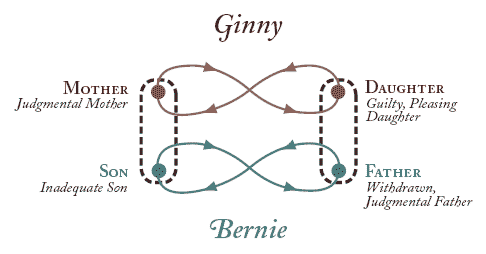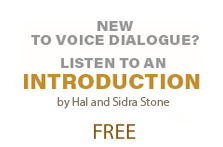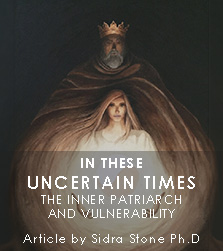by Hal Stone, Ph.D. & Sidra Stone, Ph.D.
This article is the second in a series of four written in 1994 for the journal, Psychotherapy in Australia. There is a natural ebb and flow in relationship, a movement between intimacy and distance. Even the most ideal relationships have moments in which intimacy is interrupted and good will is in short supply. As we studied the rhythms of relationship and these periods of discomfort, we discovered certain predictable patterns in all of them. We see these patterns as the dance of the selves in relationship, a dance in which the selves, rather than the people, interact. (These selves are discussed in our article “Embracing All Our Selves”).
We named these interactions “bonding patterns” because they are automatic, archetypal parent/child interactions, like the bonding that takes place between a parent and an infant. These bonding patterns are our natural instinctual patterns for receiving and giving nurture and love. There is nothing pathological about them. They are apparent in all relationships. We will be using a married couple to illustrate our approach, but please keep in mind that the same interactions can take place between two people of the same sex, between two people not in a primary relationship, between parents and children, between employers and employees, and even between two strangers meeting for the first time. In short, bonding patterns can occur between any two people, or any two groups of people.
The Bonding Patterns
We will use Bernie and Ginny, a married couple, to illustrate the bonding patterns in this section. When bonding patterns are operating in their positive aspect, they might well be overlooked. If Bernie’s “Responsible Father” is bonded into Ginny’s “Compliant Daughter”, the fact that there are selves are in relationship rather than Ginny and Bernie might well go unnoticed. People would observe that Bernie seems to take a lot of responsibility and that Ginny usually follows his lead, but this would not necessarily seem problematical. A positive bonding pattern is neither good nor bad, it just is. We call it a positive bonding pattern because it does not feel painful.
However, because it is a pair of selves and not people who are interacting, there is little choice available to the individuals involved and the interpersonal interactions are stereotypical. In this particular positive bonding pattern, for instance, Bernie is not able to set appropriate boundaries. Instead, his “Responsible Father” is required to meet all of Ginny’s needs as they arise. Ginny would not be able to set appropriate boundaries either, but is required to be appreciative and to defer to Bernie. This might be quite comfortable or it might begin to feel somewhat restrictive. As long as this positive bonding pattern lasts neither Bernie nor Ginny will react negatively to one another. Instead, each will ignore any subtle signs of discontent and will remain relentlessly positive about both the relationship and about the other.
The negative bonding pattern is extremely painful, however. One feels betrayed, judgmental, alone, misunderstood, helpless, hopeless, and angry. It often seems that the only way out of these bad feelings is to end the relationship. If properly understood, however, the discomfort of the negative bonding pattern provides us with both information and a great motivation to learn and to grow. It is important to note that both the positive and the negative bonding patterns require two participants. There is no such event as a bonding pattern with only one participant, it is a dance that must be danced by two.
Let us follow the relationship of Ginny and Bernie in its natural movement from a positive to a negative bonding pattern. One Monday Bernie goes to work after a lovely weekend and discovers that his business has suffered an unexpected loss. He is distraught, but, since he is an independent, reasonable and responsible man, he overlooks his feelings of disappointment and helplessness. He mobilizes all of his resources and spends his day researching alternative plans of action. When Bernie returns home that night and finds Ginny on the telephone in an animated conversation with her friend Mary, he feels unexpectedly irritated and begins to withdraw into himself. He goes into the next room, picks up the newspaper and begins to read it.
Ginny notices that Bernie doesn’t come over to kiss her as usual and, sensing his withdrawal, she quickly ends her conversation. She comes over to him, feeling somewhat apologetic and says hello. He barely answers her greeting and she asks him what is wrong. In a cool, distant voice he says: “Nothing is wrong.” Ginny has the distinct feeling that Bernie is displeased with her but she is not aware of the reason. She offers to bring him a cup of coffee, something he usually enjoys, but he says: “No, thank you.” in the same distant voice. Ginny is beside herself, trying to think of how to reinstate the weekend’s good feelings and how to make everything the way that it was.
Bernie watches Ginny’s efforts to draw him closer to her and he thinks to himself that she is really quite childlike and ineffectual. He wonders why he has not noticed this quality in her before. He finds himself thinking about all the responsibility he takes in the relationship and he begins to resent his role as the responsible one. He looks at Ginny and notices that she is a bit careless about her appearance. He finds himself comparing her to his office manager who is always immaculately groomed. Ginny definitely suffers in this comparison.
Ginny sits down near Bernie and tries to read her section of the newspaper and look relaxed. She steals a glance at him and notices for the first time that he reminds her of her father who was emotionally unavailable and withdrawn much of the time. She wonders to herself how she could have overlooked this quality in Bernie. As she thinks about Bernie’s similarity to her father, she becomes aware that they are both perfectionistic and demanding. In fact, the more she looks at Bernie, the less she likes him. As Bernie continues to read his newspaper, he finds himself getting more and more uncomfortable in Ginny’s presence.
All this is going on as Ben and Ginny sit quietly together. Nothing more is said. We would like to note here that in some relationships, these thoughts are spoken aloud. But silent or spoken, the feelings are unavoidably present and the energetic interaction is in full swing. The dance of the selves has moved into a new step and the negative bonding pattern, with its attendant misery, has begun.
Mapping the Bonding Patterns
As a therapist, how does one approach this? First, we would like to reiterate our view that this is a perfectly natural interaction in relationship. There is nothing pathological in this bonding pattern and much can be learned in terms of both relationship skills and personal growth. In order to understand these bonding patterns and to learn from them, one must ask the following questions:
1. What are the selves involved in both the positive and negative bonding patterns? Another way of putting this is: “What is the form of the bonding pattern?”
2. What triggered this negative bonding pattern? Determine what has happened to turn the positive bonding pattern into a negative one.
3. What are the disowned selves that Ginny and Bernie are mirroring to one another?
Let us consider the form of the bonding pattern
first. As we have said, a bonding pattern represents
parent/child interactions between two people, rather
than interactions between two Aware Egos. In this
negative bonding pattern, we see that Bernie’s
Judgmental Withdrawn Father is bonded into
Ginny’s Guilty, Pleasing Daughter. On the other
side of the bonding pattern, we see that Ginny’s
Judgmental Mother is bonded into Bernie’s
Inadequate Son. This bonding pattern would be
diagrammed as follows:
Now, turning to question number two. Disowned vulnerability is always the trigger for bonding patterns, either positive or negative. When we as individuals are not responsive to our own needs and do not care properly for our own vulnerable inner children, they will attach elsewhere for the care they require. It is as simple as that! In this example, we can see that Bernie disowned his vulnerability when he suffered a disappointment at work. His Responsible Father primary self came to his rescue in order to tackle the situation.
By the time Bernie came home he had totally forgotten his upset, but although his vulnerability was disowned, it was still operating underneath. Bernie’s Inner Child was counting on Ginny’s Good Mother to take care of him but Bernie did not know about this. When he entered the house and Ginny was on the phone and not available, Bernie had a sense of betrayal. But again he disowned his vulnerability. After all, he was a grown man and Ginny was entitled to speak to her friend Mary! So instead of telling Ginny about his feelings and his difficult day, he withdrew into his Withdrawn Judgmental Father and cut off all energetic connection between them. This is an automatic and natural response when there is no Aware Ego present to speak for the underlying feelings.
Ginny, in turn, disowned her feelings of vulnerability and became a Guilty Daughter when she felt Bernie’s withdrawal. With no Aware Ego available to her, she tried to mollify him from Guilty Daughter rather than talk with him as a woman about her feelings and perceptions. When this attempt at peacemaking did not work, Ginny moved into the other half of the bonding pattern and became Judgmental Mother.
Question number three involves disowned selves. We have talked about disowned selves in our earlier articles. These selves represent energies, or parts of ourselves, that are disowned or repressed in the growing up process. As each of us moves towards wholeness, there is a requirement to reintroduce these selves into our lives in a responsible fashion. This does not mean that we must become these selves, but it does mean that we embrace them and discover what they have to offer us. It is interesting to note that the discomfort of our bonding patterns propels us into the next stage of growth and our judgments of one another when we are involved in these bonding patterns show us the nature of this growth, i.e., the disowned selves we must embrace.
These disowned selves are like heat-seeking missiles that come back to us through our relationships and provide the fuel that intensifies the bonding pattern.
Let us look at Bernie and Ginny to see how this works. Observe what qualities they are judging in one another. Bernie judges Ginny’s need for connection and affection, her lack of responsibility, her ineffectuality, and her lack of attention to detail. These are his disowned selves. His primary selves are more withdrawn, impersonal, responsible, controlling and perfectionistic, just the qualities that Ginny is judging. Ginny’s primary selves are personal, relaxed, not needing to be in control, and able to receive from others. We might note that the judgments as stated by the primary selves make the disowned selves sound negative, but this “bitter” medicine is just what is required.
As a therapist, you can see how this relationship is a great teacher for both Bernie and Ginny and how the analysis of the bonding pattern presents them with the lessons they need to learn. We can also see how easy it would be for Ginny and Bernie would grow further and further apart if they were to continue to look at one another and judge their disowned selves rather than step back to see what there is to learn about them.
Working With the Bonding Patterns
There are numerous ways in which you as a therapist can use the knowledge of bonding patterns in your work. You can use these ideas subtly, integrating them into your work without discussing them directly, or you can work with clients using the bonding patterns and the concepts of the psychology of selves as your basic format.
We have found that the introduction of these ideas to a client is immediately helpful. This is a nofault, non-pathological way to look at relationship which can cut through a good deal of defensiveness and resistance and allow you as the therapist to work with basic issues immediately. The underlying assumptions are: (1) It takes two people to dance and (2) All bonding patterns are natural events that will reappear from time to time. (3) Relationship is a teacher. We have found that clients who read Embracing Each Other or listen to our audiocassette tape set “Making Relationships Work for You” have an excellent frame of reference for subsequent work in therapy.
We suggest that when you work with an individual or with a couple concerning issues of relationship, you map their bonding patterns as we have illustrated in the previous section. This map would include the three aspects of the bonding pattern: (1) the form of the bonding pattern which shows the selves that are interacting, (2) the vulnerability that triggered the bonding pattern, and (3) the disowned selves that are being mirrored. Once your client or clients have this map available, they have access to a great deal of information about themselves and their relationships. This actually creates an objective awareness of what is happening in their relationship even if they are not yet in a position to exercise choice from an Aware Ego and take appropriate action.
You are now in a position to work directly with the selves using Voice Dialogue or whatever other method you prefer. It is extremely powerful to work with a self when both people involved in the relationship are present. For instance, a therapist might work with Bernie’s Responsible Father, his primary self. As she watches this self , Ginny will discover what it looks like and sounds like, how it developed to protect Bernie’s vulnerability and how it operates in his life and in their relationship.
Ginny will also get the chance to experience the difference between the feeling of intimacy that the Responsible Father provides and the intimacy of the Aware Ego, a far different experience. It is difficult to describe this latter intimacy, but it involves a total energetic linkage between two people. If you have not had the experience of this energetic linkage, we might suggest that you contact one of the Voice Dialogue facilitators in Australia or come to one of the workshops we will be offering in Australia.
After the separation from the primary selves and the selves that become involved in the bonding patterns, the client is ready for an exploration of the disowned selves that are carried by his or her partner. This is one of the most important teachings of relationship. Each relationship offers us this gift of growth, of embracing our disowned selves.
Last, but certainly not least this work gives the therapist the opportunity to facilitate the vulnerable Inner Child. It is this child that holds the key to intimacy. When the sensitivity of the Inner Child is available, a profound energetic linkage is possible. When this sensitivity and vulnerability is not available, the contact between two people is always more rational and shallow.
The facilitation of the Inner Child in the safety of a conjoint session is a deeply moving, almost holy, experience for both people in the relationship. The observing partner is usually very deeply touched. However, the therapist must be aware of the possibility that the observing partner might be triggered into a feeling of responsibility for the Inner Child being facilitated. The fact that this child is nobody else’s responsibility should be stressed.
The therapist who has received training in the energetics of relationships can also work directly with the energetics of the bonding patterns we have described. This involves training clients to master their own energy fields, to control the actual energetic boundaries that surround them, to learn how to link with and how to release one another, and to learn how to intensify or lessen the power of the various selves. These are all very valuable lessons.
In Closing
Relationships challenge us to grow. Each relationship
carries within it the guidance for our
further development and growth as well as the
seeds of its own destruction. We as therapists are
in the position to move deeply into the mysteries
and complexities of these relationships, to
map the territories to be explored and to use the
information provided by relationships to guide
our clients in developing their full potential.
© 1994







